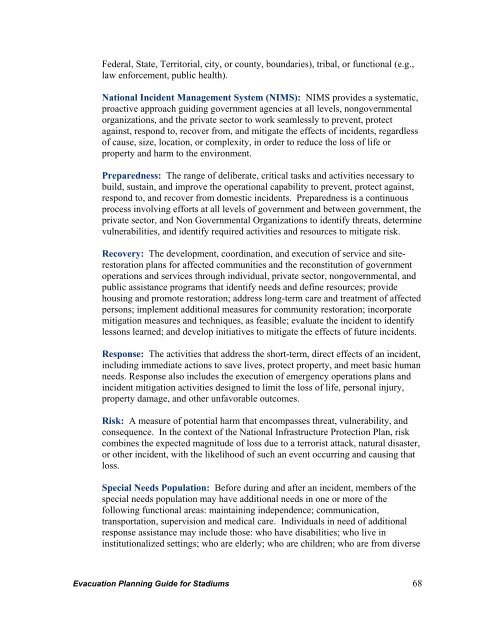Evacuation Planning Guide for Stadiums
Evacuation Planning Guide for Stadiums
Evacuation Planning Guide for Stadiums
You also want an ePaper? Increase the reach of your titles
YUMPU automatically turns print PDFs into web optimized ePapers that Google loves.
Federal, State, Territorial, city, or county, boundaries), tribal, or functional (e.g.,<br />
law en<strong>for</strong>cement, public health).<br />
National Incident Management System (NIMS): NIMS provides a systematic,<br />
proactive approach guiding government agencies at all levels, nongovernmental<br />
organizations, and the private sector to work seamlessly to prevent, protect<br />
against, respond to, recover from, and mitigate the effects of incidents, regardless<br />
of cause, size, location, or complexity, in order to reduce the loss of life or<br />
property and harm to the environment.<br />
Preparedness: The range of deliberate, critical tasks and activities necessary to<br />
build, sustain, and improve the operational capability to prevent, protect against,<br />
respond to, and recover from domestic incidents. Preparedness is a continuous<br />
process involving ef<strong>for</strong>ts at all levels of government and between government, the<br />
private sector, and Non Governmental Organizations to identify threats, determine<br />
vulnerabilities, and identify required activities and resources to mitigate risk.<br />
Recovery: The development, coordination, and execution of service and siterestoration<br />
plans <strong>for</strong> affected communities and the reconstitution of government<br />
operations and services through individual, private sector, nongovernmental, and<br />
public assistance programs that identify needs and define resources; provide<br />
housing and promote restoration; address long-term care and treatment of affected<br />
persons; implement additional measures <strong>for</strong> community restoration; incorporate<br />
mitigation measures and techniques, as feasible; evaluate the incident to identify<br />
lessons learned; and develop initiatives to mitigate the effects of future incidents.<br />
Response: The activities that address the short-term, direct effects of an incident,<br />
including immediate actions to save lives, protect property, and meet basic human<br />
needs. Response also includes the execution of emergency operations plans and<br />
incident mitigation activities designed to limit the loss of life, personal injury,<br />
property damage, and other unfavorable outcomes.<br />
Risk: A measure of potential harm that encompasses threat, vulnerability, and<br />
consequence. In the context of the National Infrastructure Protection Plan, risk<br />
combines the expected magnitude of loss due to a terrorist attack, natural disaster,<br />
or other incident, with the likelihood of such an event occurring and causing that<br />
loss.<br />
Special Needs Population: Be<strong>for</strong>e during and after an incident, members of the<br />
special needs population may have additional needs in one or more of the<br />
following functional areas: maintaining independence; communication,<br />
transportation, supervision and medical care. Individuals in need of additional<br />
response assistance may include those: who have disabilities; who live in<br />
institutionalized settings; who are elderly; who are children; who are from diverse<br />
<strong>Evacuation</strong> <strong>Planning</strong> <strong>Guide</strong> <strong>for</strong> <strong>Stadiums</strong> 68


